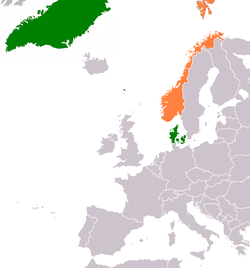Denmark–Norway relations
 |
|
Denmark |
Norway |
|---|---|

Denmark–Norway relations are foreign relations between Denmark and Norway. The countries have a very long history together: they were both part of the Kalmar Union between 1397 and 1523, and Norway was in Union with Denmark between 1524 and 1814.
The two countries established diplomatic relations in 1905, after Norway ended its union with Sweden. Denmark has an embassy in Oslo. Norway has an embassy in Copenhagen.
Both countries are full members of the Nordic Council, Council of the Baltic Sea States, of NATO, and of the Council of Europe. There are around 15,000 Norwegians living in Denmark[1] and around 20,000 Danes living in Norway.[2]
Kalmar Union
The Kalmar Union is a historiographical term meaning a series of personal unions that united the three kingdoms of Denmark, Norway (with Iceland, Greenland, Faroe Islands, Shetland, and Orkney), and Sweden (including Finland) under a single monarch, though intermittently and with a population less than 3,000,000.[3]
The countries had not technically given up their sovereignty, nor their independence, but in practical terms, they were not autonomous, the common monarch holding the sovereignty and, particularly, leading foreign policy; diverging interests (especially the Swedish nobility's dissatisfaction over the dominant role played by Denmark and Holstein) gave rise to a conflict that would hamper the union in several intervals from the 1430s until the union's breakup in 1523 when Gustav Vasa became king of Sweden.
Norway and its overseas dependencies, however, continued to remain a part of the realm of Denmark–Norway under the Oldenburg dynasty for several centuries until its dissolution in 1814.
Denmark–Norway
Denmark–Norway is the historiographical name for a former political entity consisting of the kingdoms of Denmark and Norway, including the originally Norwegian dependencies of Iceland, Greenland and the Faroe Islands. Following the strife surrounding the break-up of its predecessor, the Kalmar Union, the two kingdoms entered into another personal union in 1524 which lasted until 1814. The corresponding adjective and demonym is Dano-Norwegian.
The term Kingdom of Denmark is sometimes used to include both countries in the period 1536–1660, since the political and economic power emanated from Copenhagen, Denmark. The term covers the "royal part" of the Oldenburgs as it was in 1460, excluding the "ducal part" of Schleswig and Holstein. The administration used two official languages, Danish and German, and for several centuries both a Danish and German Chancery existed.[4]
Denmark and Norway parted when the union was dissolved in 1814. Iceland, which legally became a Danish colony in 1814, became an independent country in 1918 in a personal union, which would end in 1944.
World War II
Both Denmark and Norway were occupied by Germany with relatively light casualties.[5]
See also
- Foreign relations of Denmark
- Foreign relations of Norway
- Danish humanitarian aid to Norway during World War II
- Danish and Norwegian alphabet
- Differences between Norwegian Bokmål and Standard Danish
- Royal Dano-Norwegian Navy
- Treaty of Copenhagen (1660)
- Danish colonization of the Americas
References
- ↑ "Statistical Yearbook 2009, Table 17" (pdf). Danish Government website. Retrieved 10 January 2011.
- ↑ Statistics Norway
- ↑ Boraas, Tracey (2002). Sweden. Capstone Press. p. 24. ISBN 0-7368-0939-2.
- ↑ Rigsarkivets Samlinger. Arkivalier før 1848. Danske kancelli 1454–1848; Rigsarkivets Samlinger. Arkivalier før 1848. Tyske kancelli.
- ↑ uboat.net Norwegian Fleet Losses

